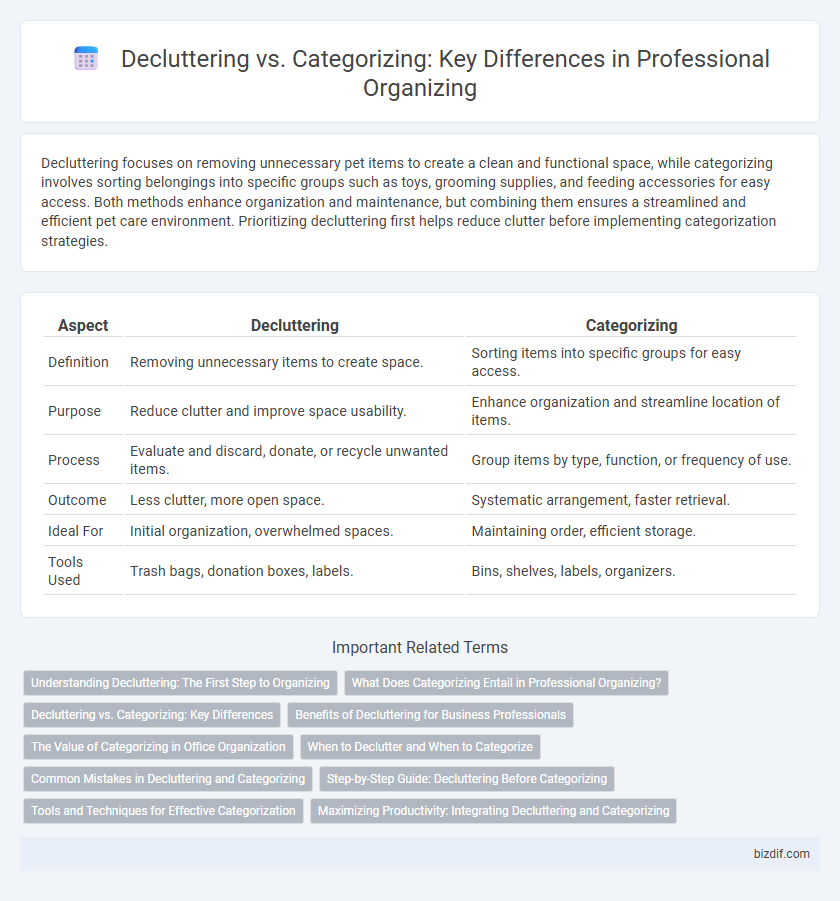Decluttering focuses on removing unnecessary pet items to create a clean and functional space, while categorizing involves sorting belongings into specific groups such as toys, grooming supplies, and feeding accessories for easy access. Both methods enhance organization and maintenance, but combining them ensures a streamlined and efficient pet care environment. Prioritizing decluttering first helps reduce clutter before implementing categorization strategies.
Table of Comparison
| Aspect | Decluttering | Categorizing |
|---|---|---|
| Definition | Removing unnecessary items to create space. | Sorting items into specific groups for easy access. |
| Purpose | Reduce clutter and improve space usability. | Enhance organization and streamline location of items. |
| Process | Evaluate and discard, donate, or recycle unwanted items. | Group items by type, function, or frequency of use. |
| Outcome | Less clutter, more open space. | Systematic arrangement, faster retrieval. |
| Ideal For | Initial organization, overwhelmed spaces. | Maintaining order, efficient storage. |
| Tools Used | Trash bags, donation boxes, labels. | Bins, shelves, labels, organizers. |
Understanding Decluttering: The First Step to Organizing
Decluttering involves removing unnecessary items to create a streamlined space, which enhances focus and reduces stress. It serves as the essential first step before categorizing, ensuring only relevant belongings are sorted. Prioritizing decluttering maximizes efficiency in professional organizing by preventing overwhelm and creating clarity.
What Does Categorizing Entail in Professional Organizing?
Categorizing in professional organizing involves sorting items into specific groups based on their function, frequency of use, or personal preference to create an intuitive, accessible system. This process requires analyzing the purpose of each item and assigning it to a logical category that enhances efficiency and simplifies retrieval. Effective categorizing transforms clutter into organized zones, improving both space utilization and user experience.
Decluttering vs. Categorizing: Key Differences
Decluttering involves removing unnecessary items to create a more functional and stress-free space, while categorizing focuses on sorting belongings into specific groups for easier access and organization. Decluttering prioritizes reducing physical and mental clutter by eliminating unused or unwanted possessions, whereas categorizing enhances efficiency by grouping similar items together. Effective professional organizing balances decluttering with categorizing to optimize space utilization and maintain long-term order.
Benefits of Decluttering for Business Professionals
Decluttering boosts productivity for business professionals by creating a clean, distraction-free workspace that enhances focus and efficiency. It streamlines access to essential documents and tools, reducing time wasted on searching and minimizing stress. This organized environment supports clear decision-making and promotes a professional image during meetings and client interactions.
The Value of Categorizing in Office Organization
Categorizing in office organization significantly enhances productivity by creating a streamlined system for locating documents and supplies, reducing time wasted on searching. Unlike simple decluttering, categorizing involves grouping items by function or project, which supports efficient workflow and minimizes distractions. Implementing clear categories also fosters consistency and easier maintenance, ensuring a sustainable organized environment.
When to Declutter and When to Categorize
Decluttering is essential when items no longer serve a purpose or bring joy, reducing physical and mental clutter to create a clean, functional space. Categorizing becomes crucial after decluttering, organizing remaining possessions by type, frequency of use, or location to enhance accessibility and efficiency. Prioritize decluttering for outdated or unused belongings, and categorize regularly used items to maintain order and streamline daily routines.
Common Mistakes in Decluttering and Categorizing
Common mistakes in decluttering and categorizing include over-categorizing items, which leads to unnecessary complexity, and failing to regularly reassess categories, causing accumulation of unused belongings. Many overlook the importance of setting clear criteria for what stays or goes, resulting in clutter retention. Ineffective sorting methods often mix sentimental and functional items, hindering the decision-making process essential for a streamlined space.
Step-by-Step Guide: Decluttering Before Categorizing
Start by removing all items from the space to create a clear visual of clutter for effective decluttering. Sort belongings into three piles: keep, donate, and discard, ensuring only essential items remain. After decluttering, categorize the retained items by function or frequency of use to optimize organization and accessibility.
Tools and Techniques for Effective Categorization
Effective categorization in professional organizing relies on tools like color-coded labels, clear storage bins, and digital inventory apps to streamline identification and retrieval. Techniques such as grouping items by function, frequency of use, and size enhance spatial efficiency and ease of access. Leveraging these tools and methods enables systematic decluttering, transforming chaotic spaces into organized environments.
Maximizing Productivity: Integrating Decluttering and Categorizing
Maximizing productivity in professional organizing requires the seamless integration of decluttering and categorizing to create efficient, functional spaces. Decluttering removes unnecessary items that distract and consume time, while categorizing systematically arranges essential belongings for quick access and optimized workflow. This dual approach enhances focus, reduces stress, and promotes sustained organization in personal and professional environments.
decluttering vs categorizing Infographic

 bizdif.com
bizdif.com